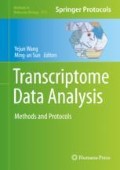Abstract
Microarray data have vastly accumulated in the past two decades. Due to the high-throughput characteristic of microarray techniques, it has transformed biological studies from specific genes to transcriptome level, and deeply boosted many fields of biological studies. While microarray offers great advantages for expression profiling, on the other hand it faces a lot challenges for computational analysis. In this chapter, we demonstrate how to perform standard analysis including data preprocessing, quality assessment, differential expression analysis, and general downstream analyses.
Access this chapter
Tax calculation will be finalised at checkout
Purchases are for personal use only
References
Schena M, Shalon D, Davis RW, Brown PO (1995) Quantitative monitoring of gene expression patterns with a complementary DNA microarray. Science 270(5235):467–470
Allison DB, Cui X, Page GP, Sabripour M (2006) Microarray data analysis: from disarray to consolidation and consensus. Nat Rev Genet 7(1):55–65. https://doi.org/10.1038/nrg1749
Hoheisel JD (2006) Microarray technology: beyond transcript profiling and genotype analysis. Nat Rev Genet 7(3):200–210. https://doi.org/10.1038/nrg1809
Canales RD, Luo Y, Willey JC, Austermiller B, Barbacioru CC, Boysen C, Hunkapiller K, Jensen RV, Knight CR, Lee KY, Ma Y, Maqsodi B, Papallo A, Peters EH, Poulter K, Ruppel PL, Samaha RR, Shi L, Yang W, Zhang L, Goodsaid FM (2006) Evaluation of DNA microarray results with quantitative gene expression platforms. Nat Biotechnol 24(9):1115–1122. https://doi.org/10.1038/nbt1236
Malone JH, Oliver B (2011) Microarrays, deep sequencing and the true measure of the transcriptome. BMC Biol 9:34. https://doi.org/10.1186/1741-7007-9-34
Taylor S, Huang Y, Mallett G, Stathopoulou C, Felizardo TC, Sun MA, Martin EL, Zhu N, Woodward EL, Elias MS, Scott J, Reynolds NJ, Paul WE, Fowler DH, Amarnath S (2017) PD-1 regulates KLRG1+ group 2 innate lymphoid cells. J Exp Med 214(6):1663–1678. https://doi.org/10.1084/jem.20161653
The Cancer Genome Atlas Research Network, Weinstein JN, Collisson EA, Mills GB, Shaw KR, Ozenberger BA, Ellrott K, Shmulevich I, Sander C, Stuart JM (2013) The Cancer Genome Atlas Pan-Cancer analysis project. Nat Genet 45(10):1113–1120. https://doi.org/10.1038/ng.2764
Kauffmann A, Gentleman R, Huber W (2009) arrayQualityMetrics – a bioconductor package for quality assessment of microarray data. Bioinformatics 25(3):415–416. https://doi.org/10.1093/bioinformatics/btn647
Eijssen LM, Jaillard M, Adriaens ME, Gaj S, de Groot PJ, Muller M, Evelo CT (2013) User-friendly solutions for microarray quality control and pre-processing on ArrayAnalysis.org. Nucleic Acids Res 41(Web Server issue):W71–W76. https://doi.org/10.1093/nar/gkt293
Wilson CL, Miller CJ (2005) Simpleaffy: a BioConductor package for Affymetrix Quality Control and data analysis. Bioinformatics 21(18):3683–3685. https://doi.org/10.1093/bioinformatics/bti605
Lim WK, Wang K, Lefebvre C, Califano A (2007) Comparative analysis of microarray normalization procedures: effects on reverse engineering gene networks. Bioinformatics 23(13):i282–i288. https://doi.org/10.1093/bioinformatics/btm201
Tusher VG, Tibshirani R, Chu G (2001) Significance analysis of microarrays applied to the ionizing radiation response. Proc Natl Acad Sci U S A 98(9):5116–5121. https://doi.org/10.1073/pnas.091062498
Breitling R, Armengaud P, Amtmann A, Herzyk P (2004) Rank products: a simple, yet powerful, new method to detect differentially regulated genes in replicated microarray experiments. FEBS Lett 573(1-3):83–92. https://doi.org/10.1016/j.febslet.2004.07.055
Ritchie ME, Phipson B, Wu D, Hu Y, Law CW, Shi W, Smyth GK (2015) limma powers differential expression analyses for RNA-sequencing and microarray studies. Nucleic Acids Res 43(7):e47. https://doi.org/10.1093/nar/gkv007
Huber W, Carey VJ, Gentleman R, Anders S, Carlson M, Carvalho BS, Bravo HC, Davis S, Gatto L, Girke T, Gottardo R, Hahne F, Hansen KD, Irizarry RA, Lawrence M, Love MI, MacDonald J, Obenchain V, Oles AK, Pages H, Reyes A, Shannon P, Smyth GK, Tenenbaum D, Waldron L, Morgan M (2015) Orchestrating high-throughput genomic analysis with Bioconductor. Nat Methods 12(2):115–121. https://doi.org/10.1038/nmeth.3252
Carvalho B (2015) pd.mogene.2.0.st: Platform Design Info for Affymetrix MoGene-2_0-st. R package version 3141
MacDonald JW (2016) mogene20sttranscriptcluster.db: Affymetrix mogene20 annotation data (chip mogene20sttranscriptcluster). R package version 850
Carvalho BS, Irizarry RA (2010) A framework for oligonucleotide microarray preprocessing. Bioinformatics 26(19):2363–2367. https://doi.org/10.1093/bioinformatics/btq431
Quackenbush J (2002) Microarray data normalization and transformation. Nat Genet 32(Suppl):496–501. https://doi.org/10.1038/ng1032
Bourgon R, Gentleman R, Huber W (2010) Independent filtering increases detection power for high-throughput experiments. Proc Natl Acad Sci U S A 107(21):9546–9551. https://doi.org/10.1073/pnas.0914005107
Hackstadt AJ, Hess AM (2009) Filtering for increased power for microarray data analysis. BMC Bioinformatics 10:11. https://doi.org/10.1186/1471-2105-10-11
Gentleman R, Carey V, Huber W, Hahne F (2016) genefilter: methods for filtering genes from high-throughput experiments. R package version 1560
D'Haeseleer P (2005) How does gene expression clustering work? Nat Biotechnol 23(12):1499–1501. https://doi.org/10.1038/nbt1205-1499
Kolde R (2015) pheatmap: Pretty Heatmaps. R package version 108
Jaskowiak PA, Campello RJ, Costa IG (2014) On the selection of appropriate distances for gene expression data clustering. BMC Bioinformatics 15(Suppl 2):S2. https://doi.org/10.1186/1471-2105-15-S2-S2
Falcon S, Gentleman R (2007) Using GOstats to test gene lists for GO term association. Bioinformatics 23(2):257–258. https://doi.org/10.1093/bioinformatics/btl567
Huang d W, Sherman BT, Lempicki RA (2009) Systematic and integrative analysis of large gene lists using DAVID bioinformatics resources. Nat Protoc 4(1):44–57. https://doi.org/10.1038/nprot.2008.211
Subramanian A, Tamayo P, Mootha VK, Mukherjee S, Ebert BL, Gillette MA, Paulovich A, Pomeroy SL, Golub TR, Lander ES, Mesirov JP (2005) Gene set enrichment analysis: a knowledge-based approach for interpreting genome-wide expression profiles. Proc Natl Acad Sci U S A 102(43):15545–15550. https://doi.org/10.1073/pnas.0506580102
Acknowledgments
This work was supported by a Natural Science Funding of Shenzhen (JCYJ201607115221141) and a Shenzhen Peacock Plan fund (827-000116) to YW. The funders had no role in study design, data collection and analysis, decision to publish, or preparation of the manuscript.
Author information
Authors and Affiliations
Editor information
Editors and Affiliations
Rights and permissions
Copyright information
© 2018 Springer Science+Business Media, LLC
About this protocol
Cite this protocol
Sun, Ma., Shao, X., Wang, Y. (2018). Microarray Data Analysis for Transcriptome Profiling. In: Wang, Y., Sun, Ma. (eds) Transcriptome Data Analysis. Methods in Molecular Biology, vol 1751. Humana Press, New York, NY. https://doi.org/10.1007/978-1-4939-7710-9_2
Download citation
DOI: https://doi.org/10.1007/978-1-4939-7710-9_2
Published:
Publisher Name: Humana Press, New York, NY
Print ISBN: 978-1-4939-7709-3
Online ISBN: 978-1-4939-7710-9
eBook Packages: Springer Protocols

